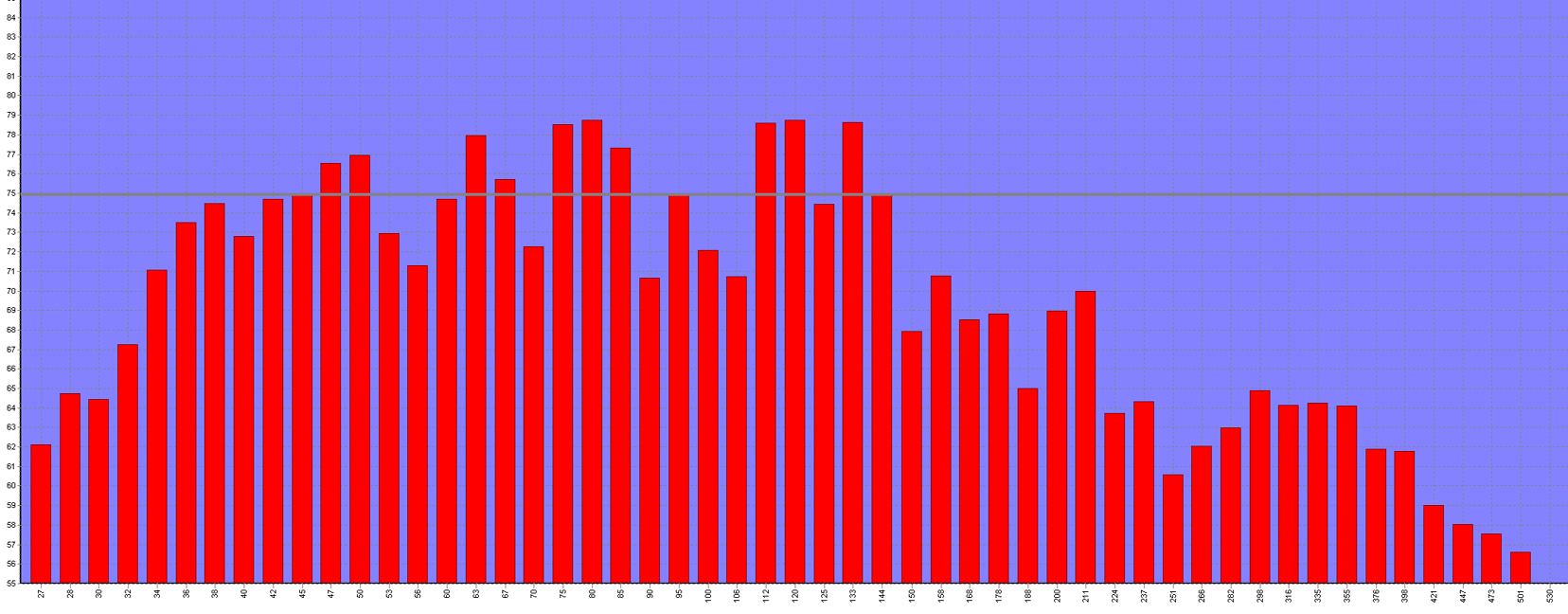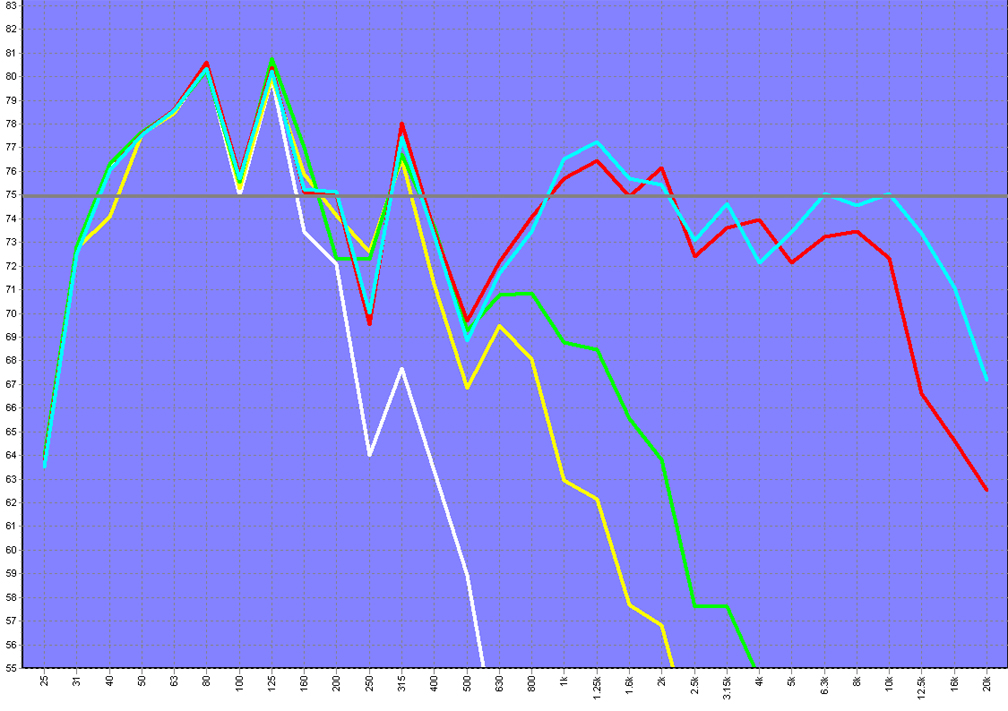Rerurn to Romy the Cat's Site
In the Forum: Horn-Loaded Speakers
In the Thread: Macondo’s Midbass Project – the grown up time.
Post Subject: The another day of midbass.Posted by Romy the Cat on: 10/3/2010
fiogf49gjkf0d
OK, this morning I tuned the playback and did some listing, trying to understand what was the problem. Sound was not just bad but it was very strange, it was almost as a mechanical replica of sound. I took my phase meter trying to set horns in phase with the rest of the system and I was shocked how the horns reacted to the 2+1 phase pulses. Any speakers do it like claps but my horns presented it almost as VC was rubbing the gap. Also, the midbass horn did not react to crossover properly- it output pretty much the same horribly-compressed MF sound aka a telephone from 30s….. This was no what I was signed for.
I decided to poke a small whole in back chamber on one of the horns and to see if it would impact resonance frequency. I disagree with el`Ol that the foam I use is too soft. It tested many time – this type of foam for the purpose of filling back chamber is as good as solid brick. I made a small 1-2mm hole from the driver window to outside and measured the resonance – there was no fucking resonance. I decided that foam glued the cone and the game is over- I started to cut the foam to replace the driver.
When I reached the level of fabric cover the window I realized that the fabric was not perpetrated by foam and the driver’s diaphragm was in absolutely intact virgin state. What the hell – I was asking myself. I opened one whole basket‘s window and measured the resonance frequency. To my huge surprise I did see the resonance now. It was 54.6Hz. I need to mention that the resonance was nothing even remotely close to what I had in basement. In basement it was almost 50%, very sharp impedance dive, her in the room, it was more like 5-10% and very smooth dive. I took foams from one more window - 52Hz. Eventually I took all non-compressible foams out of the chamber. The resonance drooped to 50Hz, or to the resonance of the driver in open air. Then I opened the back chamber lid wide open. The resonance dropped to 43.7Hz. That was already something but I needed a few more Hz, and I would like to keep the primary resonance just under 42Hz. I decided to fill the back chamber with compressible foam (furniture foam) that shall virtually expend the chamber volume. Laying the chamber with furniture foam made the resonance to rise to 47Hz. I deseeded to keep the back chamber wide open for now with 43.7Hz of primary resonance.
I reset the playback to run from generator to preamp and give it a try to play music. Here it was – the bass was as it had to be in its shine. OK, what does it all means?
The events I describe are hugely educational. As now I understand I did wrong the size of the back chamber - it had to be as I initially thought - the 3 sizes of the driver total volume. However, disagree with the criticism that I did anything wrong. What I did was the only methods I trust in loudspeakers design -following my own empirical results. In the middle of the thread I did tell that the reflective condition in the listening room will be different then reflective condition of the basement and the horns will “read” the walls differently. That is why I thought to make the adjustable back chamber – to fine-tune the chamber after the horns will be installed. What I did not know and did anticipated was that the amplitude of the differences between room and basement will be so huge. The super small size of the back chamber was absolutely right for the basement location but absolutely incorrect for the room where horns see no reflections of any kind. A 50Hz driver shooting toward to wall via a horn like mine experience throat reactance that made resonance drop to 24Hz. In open air however it the drop goes to 43.7Hz. This is indication that throat reactance is not only derivative of the air mass in the belly of the horn but also hugely moderated by the reflective characteristics of the room profile. I generally know about but I have no idea that the degree of this moderation might be near 100%.
This experience of mine give a huge room of thoughts, explanations and doubts. Generally people do not talk, do not think, and do not question it. What you can see on-line is a person make a picture of his shiny horn but no one question how the horn sound and what ingredients made it’s sound. I question everything and I expose everything in this thread. One might by $40K Goto bass driver, or some exotic bass electromagnet and feel that hell all set but did you ever see those people ever question or publish own resonance frequency of their horns. Without know the bass horn resonance frequency and ability to moderate it for a give location a bass horn in pretty much unturned instrument that produces absolutely accidental result. I wish that this conclusion would be a legacy of my projects.
Anyhow, it turned out the in my horn, shooting in non-reflective room pushed the Vitavox driver to it’s limit. The 43.7Hz is a bit short but the driver has no cone mass to go lower. I would like to find a way to drop it for 3-4 Hz lower but I am hesitant to glue anything to the driver. The back chamber is open and I need to devise some kind of thermal solution to unclose the driver that would not impact the resonance.
At this point the midbass channel is more or less operate properly. It sounds fine and here is the frequency response of left Midbass after a 70Hz low pass 6dB filter.

I might start to work on the midbass sound and on the midbass integration with Macondo. I need to mention that Macondo since I moved to the new room did not have any proper setup done. Now I need to review the enter Macondo in context of the Midbass channels and the ULF channel. Midbass now a lot of louder then Macondo, 7R resistor set it equal but I am not sure how I will reduce the Midbass volume. I would like to do it by dropping loading of the Midbass out transformer. I think it is too early to think about it, I need to revise many other things. For whatever it worth he is the Macondo’s left channel raw initial sweep, for each channel but without the Injection Channel. It sure will be see a lot of work and will be a lot of better.

Now it will be interesting time – a lot of listening and a lot of thinking, No more wood cutting and dust. That will be in way very interesting time – to make Melquiades, Macondo and the Room to sound properly. Even as now, listening what they do, I do see a lot of potential but it for sure need to have a lot of fine polishing of sound. As my carpenter do some minor cosmetics modification this well I will put the room treatment in the game and for now I am beginning to work on new crossovers.
Rgs, Romy the CatRerurn to Romy the Cat's Site